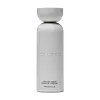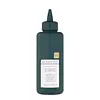What's inside
What's inside
 Key Ingredients
Key Ingredients

 Benefits
Benefits

 Concerns
Concerns

 Ingredients Side-by-side
Ingredients Side-by-side

Water
Skin ConditioningSodium Lauroyl Methyl Isethionate
CleansingGlycerin
HumectantCocamidopropyl Betaine
CleansingPolyquaternium-7
Polyquaternium-10
Glycol Distearate
EmollientHydrolyzed Rice Protein
Skin ConditioningLactobacillus
Skin ConditioningOlea Europaea Fruit Oil
MaskingMoringa Oleifera Seed Oil
EmollientAdansonia Digitata Seed Oil
EmollientNigella Sativa Seed Oil
EmollientArgania Spinosa Kernel Oil
EmollientRosmarinus Officinalis Leaf Oil
MaskingSodium Hyaluronate
HumectantHyssopus Officinalis Extract
MaskingCoco-Glucoside
CleansingGlyceryl Oleate
EmollientGuar Hydroxypropyltrimonium Chloride
Skin ConditioningHydrolyzed Hyaluronic Acid
HumectantEclipta Prostrata Extract
Skin ConditioningHibiscus Rosa-Sinensis Flower Extract
HumectantChlorella Ferment
Skin ConditioningTremella Fuciformis Polysaccharide
Emulsion StabilisingCaramel
Cosmetic ColorantSodium Phytate
1,2-Hexanediol
Skin ConditioningHydroxyethylcellulose
Emulsion StabilisingParfum
MaskingEthylhexylglycerin
Skin ConditioningPhenoxyethanol
PreservativeTrisodium Ethylenediamine Disuccinate
Sodium Benzoate
MaskingSodium Phosphate
BufferingCitric Acid
BufferingTocopherol
AntioxidantHydrogenated Palm Glycerides Citrate
EmollientDisodium Phosphate
BufferingPolysorbate 60
EmulsifyingBenzyl Alcohol
PerfumingPotassium Sorbate
PreservativeLactic Acid
BufferingLinalool
PerfumingWater, Sodium Lauroyl Methyl Isethionate, Glycerin, Cocamidopropyl Betaine, Polyquaternium-7, Polyquaternium-10, Glycol Distearate, Hydrolyzed Rice Protein, Lactobacillus, Olea Europaea Fruit Oil, Moringa Oleifera Seed Oil, Adansonia Digitata Seed Oil, Nigella Sativa Seed Oil, Argania Spinosa Kernel Oil, Rosmarinus Officinalis Leaf Oil, Sodium Hyaluronate, Hyssopus Officinalis Extract, Coco-Glucoside, Glyceryl Oleate, Guar Hydroxypropyltrimonium Chloride, Hydrolyzed Hyaluronic Acid, Eclipta Prostrata Extract, Hibiscus Rosa-Sinensis Flower Extract, Chlorella Ferment, Tremella Fuciformis Polysaccharide, Caramel, Sodium Phytate, 1,2-Hexanediol, Hydroxyethylcellulose, Parfum, Ethylhexylglycerin, Phenoxyethanol, Trisodium Ethylenediamine Disuccinate, Sodium Benzoate, Sodium Phosphate, Citric Acid, Tocopherol, Hydrogenated Palm Glycerides Citrate, Disodium Phosphate, Polysorbate 60, Benzyl Alcohol, Potassium Sorbate, Lactic Acid, Linalool
Water
Skin ConditioningSodium Lauroyl Methyl Isethionate
CleansingCocamidopropyl Betaine
CleansingGlycerin
HumectantOleth-5
EmulsifyingParfum
MaskingPhenoxyethanol
PreservativeDisteareth-100 Ipdi
Sodium Lauroamphoacetate
CleansingSodium Benzoate
MaskingCitric Acid
BufferingPolyquaternium-10
Potassium Sorbate
PreservativePolyquaternium-7
Panthenol
Skin ConditioningTrisodium Ethylenediamine Disuccinate
Butylene Glycol
HumectantHydrolyzed Pea Protein
EmollientChamomilla Recutita Flower Extract
MaskingEquisetum Hyemale Leaf/Stem Extract
Skin ConditioningEucalyptus Globulus Leaf Extract
PerfumingHydrolyzed Rice Protein
Skin ConditioningSalvia Officinalis Leaf Extract
CleansingAloe Barbadensis Leaf Juice
Skin ConditioningAlgin
MaskingCaprylic/Capric Triglyceride
MaskingCarrageenan
Chitosan
Coco-Glucoside
CleansingCocos Nucifera Fruit Extract
EmollientGuar Hydroxypropyltrimonium Chloride
Skin ConditioningHelianthus Annuus Seed Oil
EmollientLavandula Angustifolia Extract
Skin ConditioningMangifera Indica Seed Butter
Skin ConditioningPersea Gratissima Oil
Skin ConditioningRicinus Communis Seed Oil
MaskingSorbitan Oleate
EmulsifyingXanthan Gum
EmulsifyingWater, Sodium Lauroyl Methyl Isethionate, Cocamidopropyl Betaine, Glycerin, Oleth-5, Parfum, Phenoxyethanol, Disteareth-100 Ipdi, Sodium Lauroamphoacetate, Sodium Benzoate, Citric Acid, Polyquaternium-10, Potassium Sorbate, Polyquaternium-7, Panthenol, Trisodium Ethylenediamine Disuccinate, Butylene Glycol, Hydrolyzed Pea Protein, Chamomilla Recutita Flower Extract, Equisetum Hyemale Leaf/Stem Extract, Eucalyptus Globulus Leaf Extract, Hydrolyzed Rice Protein, Salvia Officinalis Leaf Extract, Aloe Barbadensis Leaf Juice, Algin, Caprylic/Capric Triglyceride, Carrageenan, Chitosan, Coco-Glucoside, Cocos Nucifera Fruit Extract, Guar Hydroxypropyltrimonium Chloride, Helianthus Annuus Seed Oil, Lavandula Angustifolia Extract, Mangifera Indica Seed Butter, Persea Gratissima Oil, Ricinus Communis Seed Oil, Sorbitan Oleate, Xanthan Gum
Ingredients Explained
These ingredients are found in both products.
Ingredients higher up in an ingredient list are typically present in a larger amount.
Citric Acid is an alpha hydroxy acid (AHA) naturally found in citrus fruits like oranges, lemons, and limes.
Like other AHAs, citric acid can exfoliate skin by breaking down the bonds that hold dead skin cells together. This helps reveal smoother and brighter skin underneath.
However, this exfoliating effect only happens at high concentrations (20%) which can be hard to find in cosmetic products.
Due to this, citric acid is usually included in small amounts as a pH adjuster. This helps keep products slightly more acidic and compatible with skin's natural pH.
In skincare formulas, citric acid can:
While it can provide some skin benefits, research shows lactic acid and glycolic acid are generally more effective and less irritating exfoliants.
Most citric acid used in skincare today is made by fermenting sugars (usually from molasses). This synthetic version is identical to the natural citrus form but easier to stabilize and use in formulations.
Read more about some other popular AHA's here:
Learn more about Citric AcidCocamidopropyl Betaine is a fatty acid created by mixing similar compounds in coconut oil and dimethylaminopropylamine, a compound with two amino groups.
This ingredient is a surfactant and cleanser. It helps gather the dirt, pollutants, and other impurities in your skin to be washed away. It also helps thicken a product and make the texture more creamy.
Being created from coconut oil means Cocamidopropyl Betaine is hydrating for the skin.
While Cocamidopropyl Betaine was believed to be an allergen, a study from 2012 disproved this. It found two compounds in unpure Cocamidopropyl Betaine to be the irritants: aminoamide and 3-dimethylaminopropylamine. High-grade and pure Cocamidopropyl Betaine did not induce allergic reactions during this study.
Learn more about Cocamidopropyl BetaineCoco-Glucoside is a surfactant, or a cleansing ingredient. It is made from glucose and coconut oil.
Surfactants help gather dirt, oil, and other pollutants from your skin to be rinsed away.
This ingredient is considered gentle and non-comedogenic. However, it may still be irritating for some.
Learn more about Coco-GlucosideGlycerin is already naturally found in your skin. It helps moisturize and protect your skin.
A study from 2016 found glycerin to be more effective as a humectant than AHAs and hyaluronic acid.
As a humectant, it helps the skin stay hydrated by pulling moisture to your skin. The low molecular weight of glycerin allows it to pull moisture into the deeper layers of your skin.
Hydrated skin improves your skin barrier; Your skin barrier helps protect against irritants and bacteria.
Glycerin has also been found to have antimicrobial and antiviral properties. Due to these properties, glycerin is often used in wound and burn treatments.
In cosmetics, glycerin is usually derived from plants such as soybean or palm. However, it can also be sourced from animals, such as tallow or animal fat.
This ingredient is organic, colorless, odorless, and non-toxic.
Glycerin is the name for this ingredient in American English. British English uses Glycerol/Glycerine.
Learn more about GlycerinThis ingredient is derived from guar gum.
It is a conditioning ingredient, meaning it helps soften skin and hair.
Hydrolyzed Rice Protein is protein extracted from rice. This ingredient is rich in antioxidants and peptides.
Studies show this ingredient may help with blocking the melanin creation process when skin is exposed to UV.
Parfum is a catch-all term for an ingredient or more that is used to give a scent to products.
Also called "fragrance", this ingredient can be a blend of hundreds of chemicals or plant oils. This means every product with "fragrance" or "parfum" in the ingredients list is a different mixture.
For instance, Habanolide is a proprietary trade name for a specific aroma chemical. When used as a fragrance ingredient in cosmetics, most aroma chemicals fall under the broad labeling category of “FRAGRANCE” or “PARFUM” according to EU and US regulations.
The term 'parfum' or 'fragrance' is not regulated in many countries. In many cases, it is up to the brand to define this term.
For instance, many brands choose to label themselves as "fragrance-free" because they are not using synthetic fragrances. However, their products may still contain ingredients such as essential oils that are considered a fragrance by INCI standards.
One example is Calendula flower extract. Calendula is an essential oil that still imparts a scent or 'fragrance'.
Depending on the blend, the ingredients in the mixture can cause allergies and sensitivities on the skin. Some ingredients that are known EU allergens include linalool and citronellol.
Parfum can also be used to mask or cover an unpleasant scent.
The bottom line is: not all fragrances/parfum/ingredients are created equally. If you are worried about fragrances, we recommend taking a closer look at an ingredient. And of course, we always recommend speaking with a professional.
Learn more about ParfumPhenoxyethanol is a preservative that has germicide, antimicrobial, and aromatic properties. Studies show that phenoxyethanol can prevent microbial growth. By itself, it has a scent that is similar to that of a rose.
It's often used in formulations along with Caprylyl Glycol to preserve the shelf life of products.
Polyquaternium-10 is an ammonium salt of hydroxyethylcellulose. It is a white and granular powder used as a film-former and anti-static agent.
This ingredient is commonly found in hair conditioning products. According to a manufacturer, its positive charge makes it great for absorbing hair proteins. The manufacturer also states this ingredient helps with curl retention.
For haircare friends: this ingredient is not a silicone.
Learn more about Polyquaternium-10Polyquaternium-7 is a light to clear colored liquid. It is commonly found in haircare products for its film-forming and anti-static properties.
According to a manufacturer, it is a non-paraben and specially developed for negatively charged surfactant systems. This makes it a great hairstyle holder and helps to improve wet hair detangling without adding buildup.
Potassium Sorbate is a preservative used to prevent yeast and mold in products. It is commonly found in both cosmetic and food products.
This ingredient comes from potassium salt derived from sorbic acid. Sorbic acid is a natural antibiotic and effective against fungus.
Both potassium sorbate and sorbic acid can be found in baked goods, cheeses, dried meats, dried fruit, ice cream, pickles, wine, yogurt, and more.
You'll often find this ingredient used with other preservatives.
Learn more about Potassium SorbateSodium Benzoate is a preservative. It's used in both cosmetic and food products to inhibit the growth of mold and bacteria. It is typically produced synthetically.
Both the US FDA and EU Health Committee have approved the use of sodium benzoate. In the US, levels of 0.1% (of the total product) are allowed.
Sodium benzoate works as a preservative by inhibiting the growth of bacteria inside of cells. It prevents the cell from fermenting a type of sugar using an enzyme called phosphofructokinase.
It is the salt of benzoic acid. Foods containing sodium benzoate include soda, salad dressings, condiments, fruit juices, wines, and snack foods.
Studies for using ascorbic acid and sodium benzoate in cosmetics are lacking, especially in skincare routines with multiple steps.
We always recommend speaking with a professional, such as a dermatologist, if you have any concerns.
Learn more about Sodium BenzoateSodium Lauroyl Methyl Isethionate is a cleansing ingredient. It is a surfactant, meaning it helps gather dirt, oil, and other pollutants. This helps them be rinsed away easily.
Trisodium Ethylenediamine Disuccinate is used to help stabilize a product.
It is a chelating agent, meaning it helps prevent metal ions from binding to other ingredients. This prevents unwanted reactions in products. Metal ions can come into a product via the water ingredient. They are found in trace amounts and are not known to be harmful.
Water. It's the most common cosmetic ingredient of all. You'll usually see it at the top of ingredient lists, meaning that it makes up the largest part of the product.
So why is it so popular? Water most often acts as a solvent - this means that it helps dissolve other ingredients into the formulation.
You'll also recognize water as that liquid we all need to stay alive. If you see this, drink a glass of water. Stay hydrated!
Learn more about Water